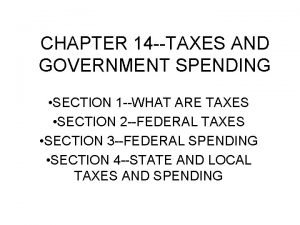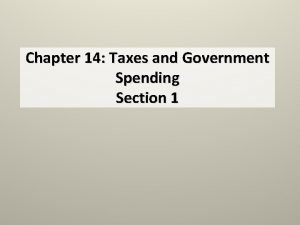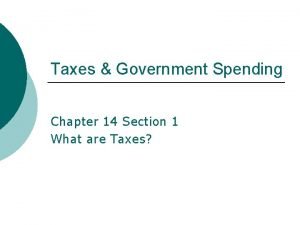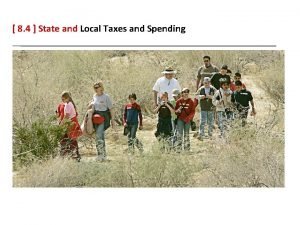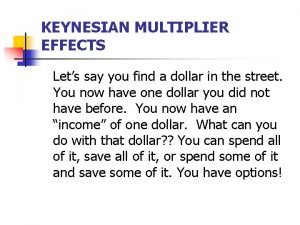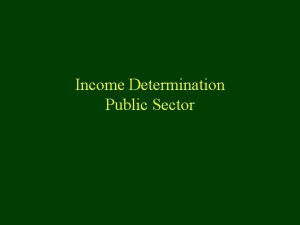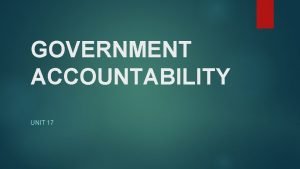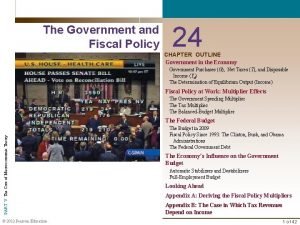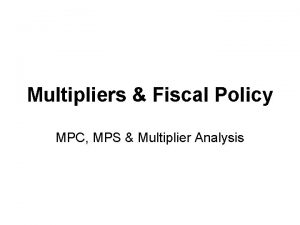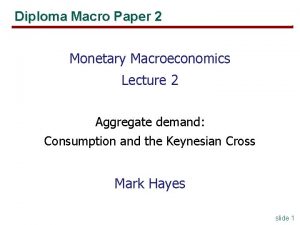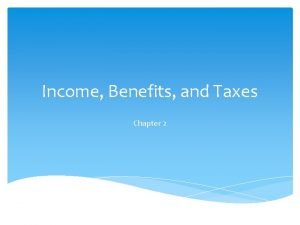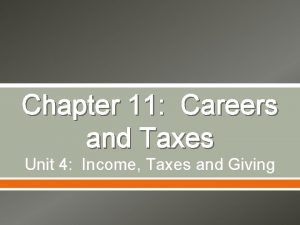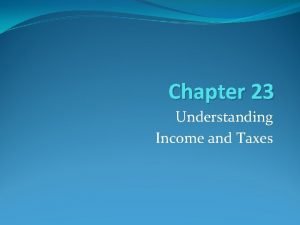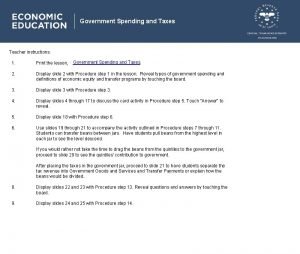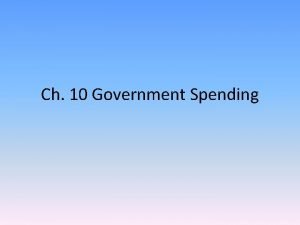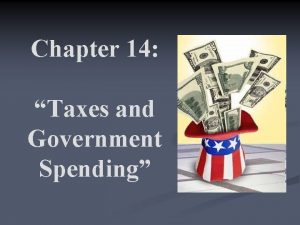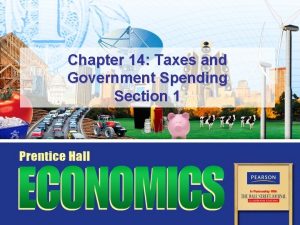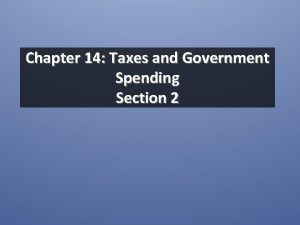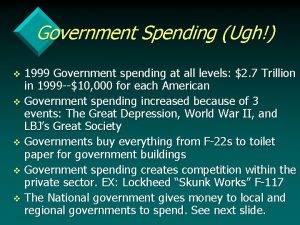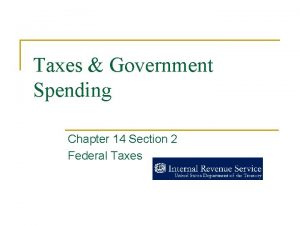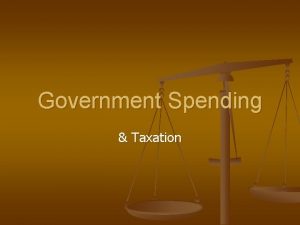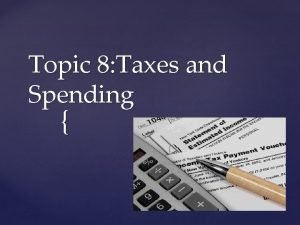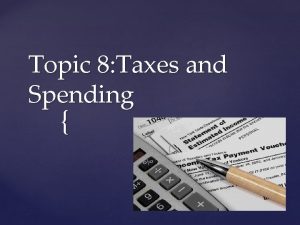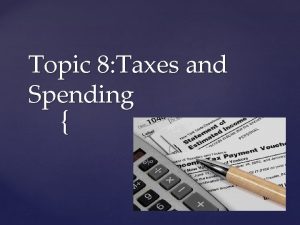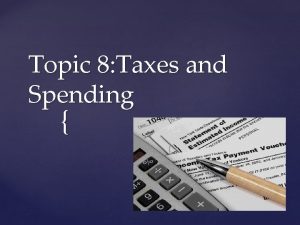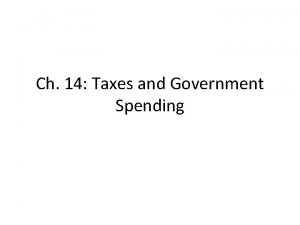Chapter 14 Taxes and Government Spending Section 1
















- Slides: 16

Chapter 14: Taxes and Government Spending Section 1

Objectives 1. Identify the sources of the government’s authority to tax. 2. Describe types of tax bases and tax structures. 3. List the characteristics of a good tax. 4. Identify who bears the burden of a tax. 2

Key Terms • tax: a required payment to a local, state, or national government • revenue: the income received by a government from taxes and other nontax sources • progressive tax: a tax for which the percentage of income paid in taxes increases as income increases • proportional tax: a tax for which the percentage of income paid in taxes remains the same at all income levels • regressive tax: a tax for which the percentage of income paid in taxes decreases as income increases 3

Key Terms, cont. • tax base: the income, property, good, or service that is subject to a tax • individual income tax: a tax based on a person’s earnings • corporate income tax: a tax based on a company’s profits • property tax: a tax based on real estate and other property • sales tax: a tax based on goods or services that are sold • incidence of tax: the final burden of a tax 4

Introduction • What are the features of a tax system? – Fairness – Simplicity – Efficiency – Certainty – Balance between tax revenue and tax rates 5

Government’s Authority to Tax • We authorize the federal government, through the Constitution and our elected representatives in Congress, to raise money in the form of taxes. – Taxation is the primary way that the government collects money. Taxes give the government the money it needs to operate. – The first power granted to Congress is the power to tax, which is the basis of all federal laws. 6

Limits on the Government • There also limits on the government’s power to tax. – The purpose of a tax must be “for the common defense and general welfare. ” A tax cannot bring in money that goes to individual interests. – Federal taxes must be the same in every state. – The government cannot tax exports, only imports. – Taxes must be divided among the states based on population 7

Progressive Taxes • Economists describe taxes based on their structure and according to the tax base. • A progressive tax is a tax for which the percentage of income paid in taxes increases as income increases.

Other Taxes • A proportional tax is a tax for which the percentage of income paid in taxes remains the same at all income levels. • A regressive tax is a tax for which the percentage of income paid in taxes decreases as income increases. – A sales tax is regressive because higher income households spend a lower proportion of their incomes on taxable goods and services. – Checkpoint: Is the federal income tax proportional, progressive, or regressive? 9

Tax Bases • Different taxes have different tax bases. – The individuals income tax is based on a person’s earnings. – The corporate income tax is based on a company’s profits. – The property tax is based on real estate and other property. – The sales tax is based on goods and services that are sold. 10

Elasticities of Demand Tax Effects • Taxes affect more than just the people who pay them. • Producers often pass on a portion of tax to consumers. – Generally, the more inelastic the demand, the more easily the seller can shift the tax to consumers. – Under what conditions, elastic or inelastic demand, would price of a good increase from $1. 00 to $1. 10?

12

Characteristics of a Good Tax • Checkpoint: What are the four characteristics of a good tax? – Simplicity—tax law should be easy to understand – Efficiency—the tax should be able to be collected without spending too much time or money – Certainty—it should be clear when the tax is due, how much is due, and how to pay the tax – Equity—the tax system should ensure that no one bears too much or too little of the tax 13

Determining Fairness • Economists have proposed two different ideas about how to measure the fairness of a tax. – The benefits-received principle holds that a person should pay taxes based on the level of benefits he or she expects to receive from the government. – The gasoline tax is an example of the benefitsreceived principle.

Determining Fairness, cont. • The ability-to-pay principle holds that people should pay taxes according to their ability to pay. • Good taxes generate enough, but not too much, revenue. Citizens needs are met, but not to such an extensive degree that the tax discourages production. 15

Review • Now that you have learned about the features of a tax system, go back and answer the Chapter Essential Question. – How can taxation meet the needs of government and the people? 16
 Chapter 14: taxes and government spending section 1
Chapter 14: taxes and government spending section 1 Chapter 14 taxes and government spending
Chapter 14 taxes and government spending Chapter 14 taxes and government spending
Chapter 14 taxes and government spending State and local taxes and spending
State and local taxes and spending Government taxes definition
Government taxes definition Government expenditure formula
Government expenditure formula Tax multiplier formula
Tax multiplier formula Budget multiplier
Budget multiplier Accountability quotes for work
Accountability quotes for work Government spending multiplier formula
Government spending multiplier formula Government spending multiplier
Government spending multiplier Tax multiplier formula
Tax multiplier formula Government spending multiplier
Government spending multiplier Chapter 2 income benefits and taxes
Chapter 2 income benefits and taxes Foundations u.com
Foundations u.com Chapter 23 understanding income and taxes
Chapter 23 understanding income and taxes Flow chapter 2
Flow chapter 2
